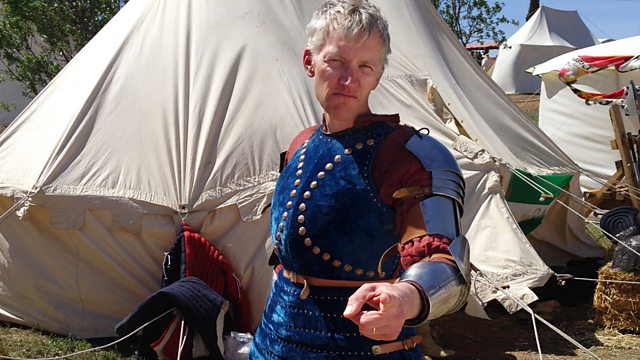Zombies in Yorkshire?
Helen Castor, Fiona Watson and Francis Pryor consider a medieval zombie apocalypse in north Yorkshire and the demise of the whisky industry in north east Scotland.
Helen Castor presents the programme that goes behind the history headlines. Scottish medievalist Fiona Watson and landscape historian Francis Pryor join Helen to discuss medieval mutilations in North Yorkshire, illegal whisky distilling in nineteenth century Scotland and the news that human beings may have evolved in Africa 100,000 years earlier than we thought.
Tom Holland travels to North Yorkshire and the deserted medieval village at Wharram Percy which archaeologists now believe was the site of a gruesome practice of mutilation in the middle ages. Dr Simon Mays is a human skeletal biologist for Historic England and he noticed some odd marks on human bones recovered at Wharram Percy in the sixties. These bones were found in the middle of the deserted village - not in the churchyard. Simon thinks the marks on them were caused by severe blows made shortly after death - maybe to stop disruptive souls from tormenting villagers again.
Whisky writer Rachel McCormack takes us to another remote and deserted location, the Cabrach between Aberdeen and Inverness. This was the centre of a well-developed, but illegal, whisky distilling industry in the eighteenth century. Although the remote location kept these stills hidden from the revenue men it also made them commercially unviable when whisky production was licensed in the 1820s. The ruined farmsteads in this otherwise untouched environment are the only clues to this tumultuous past.
Dr Vanessa King and Dr Matthew Green show Helen a seedy and brutal history of a night out on London's South Bank, and Dr John McNabb responds to news that Homo Sapiens may be 100,000 older than we once thought.
Producer: Nick Patrick
A Pier production for 主播大秀 Radio 4.
Last on
More episodes
Previous
Southwark

Recent terrorist attacks in the UK brought a defiant response, particular in the two cities where they were carried out: Manchester and London. After the knife attacks south of London Bridge on Saturday 3rd June, which claimed eight lives, the Twitter hashtag WeAreNotAfriad trended around the world. It summed up the attitude of those caught up in the horror, some of whom made it clear that what they went through wouldn鈥檛 stop them enjoying a night out in Bermondsey, Borough or other areas of historic Southwark. This is an area south of the River Thames that has a history of being the centre of bawdy entertainments, drink and prostitution spanning a millennium or more. Helen Castor met up with Vanessa King from Goldsmith鈥檚, University of London and Dr Matthew Green, author of London: A Travel Guide Through Time, to explore this long, human story.听听
听
听
听
听
听
Cabrach Whisky

Despite the popularity of brewing and distilling in the UK today, it鈥檚 odd that the area of North East Scotland which was home to whisky production right up until the 1820鈥檚 has been depopulated and distillery-less for over 150 yeas. Close to the home of the famous Speyside malts, between Inverness and Aberdeen, is a remote area that right up until the parliamentary licensing of whisky production in 1823 was peppered with illegal stills. Here, out of the reach of the customs men, an entire community was involved in making and smuggling some of the best whisky available at the time. Now, a charity is setting up a new distillery which will make Cabrach whisky and tell its history. Whisky writer, and Radio 4 regular, Rachel McCormack headed north to learn more from historian Dr Kieran German.
听
听
听
Resisting the medieval dead in Wharram Percy

Dr Simon Mays is Human Skeletal Biologist for Historic England. Over recent years he has been examining bones that were excavated at the site of Wharram Percy deserted medieval village in North Yorkshire in the 1960鈥檚. He found cut marks on them that he couldn鈥檛 explain. They didn鈥檛 seem to match anything associated with violence or even cannibalism. After some time, Simon hit upon the theory that these marks were caused by villagers dismembering bodies soon after death to insure that they didn鈥檛 come back to cause trouble in the community and his ideas are supported by the writing of clerics in documents from the Middle Ages.
听
听
听
Human Beings Just Got Older
Could Homo Sapiens be 100,000 years older than we thought? Research published in the journal Nature, explores the idea that remains found in Morocco could be over 300,000 years old and also show that we didn鈥檛 evolve only in East Africa as is commonly thought. Dr John McNabb Senior Lecturer in Palaeolithic Archaeology at the University of Southampton goes explains the research.
听
听
Broadcast
- Tue 13 Jun 2017 15:30主播大秀 Radio 4
Podcast
-
![]()
Making History
Popular history series where the past connects with the present.


